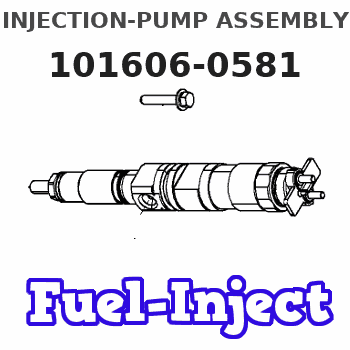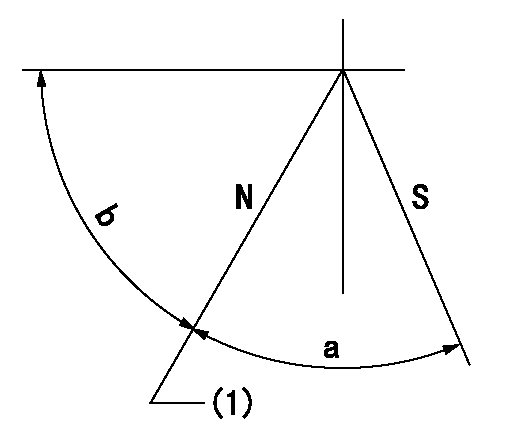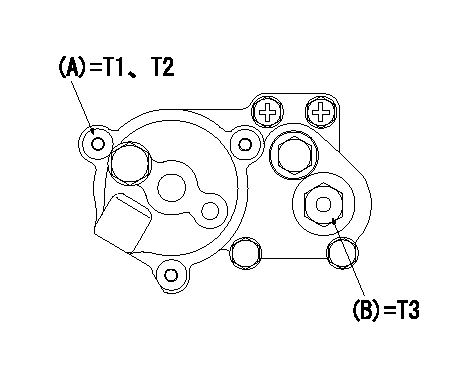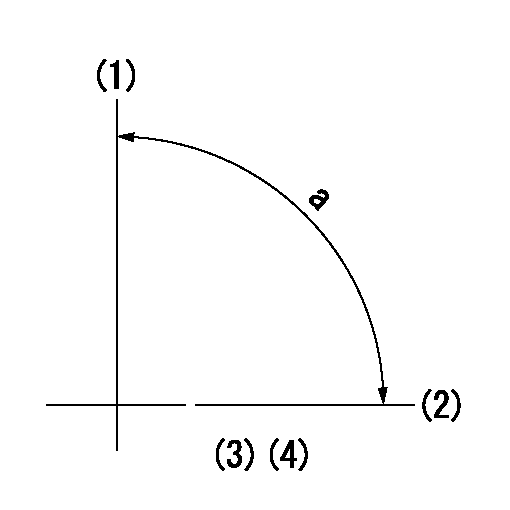Information injection-pump assembly
BOSCH
9 400 613 470
9400613470
ZEXEL
101606-0581
1016060581
ISUZU
1156035011
1156035011

Rating:
Service parts 101606-0581 INJECTION-PUMP ASSEMBLY:
1.
_
7.
COUPLING PLATE
8.
_
9.
_
11.
Nozzle and Holder
1-15300-432-1
12.
Open Pre:MPa(Kqf/cm2)
16.7{170}/19.6{200}
14.
NOZZLE
Include in #1:
101606-0581
as INJECTION-PUMP ASSEMBLY
Include in #2:
104746-6212
as _
Cross reference number
BOSCH
9 400 613 470
9400613470
ZEXEL
101606-0581
1016060581
ISUZU
1156035011
1156035011
Zexel num
Bosch num
Firm num
Name
9 400 613 470
1156035011 ISUZU
INJECTION-PUMP ASSEMBLY
6BG1-T * K 14BF PE6AD PE
6BG1-T * K 14BF PE6AD PE
Calibration Data:
Adjustment conditions
Test oil
1404 Test oil ISO4113 or {SAEJ967d}
1404 Test oil ISO4113 or {SAEJ967d}
Test oil temperature
degC
40
40
45
Nozzle and nozzle holder
105780-8140
Bosch type code
EF8511/9A
Nozzle
105780-0000
Bosch type code
DN12SD12T
Nozzle holder
105780-2080
Bosch type code
EF8511/9
Opening pressure
MPa
17.2
Opening pressure
kgf/cm2
175
Injection pipe
Outer diameter - inner diameter - length (mm) mm 6-2-600
Outer diameter - inner diameter - length (mm) mm 6-2-600
Overflow valve
134424-4120
Overflow valve opening pressure
kPa
255
221
289
Overflow valve opening pressure
kgf/cm2
2.6
2.25
2.95
Tester oil delivery pressure
kPa
255
255
255
Tester oil delivery pressure
kgf/cm2
2.6
2.6
2.6
Direction of rotation (viewed from drive side)
Right R
Right R
Injection timing adjustment
Direction of rotation (viewed from drive side)
Right R
Right R
Injection order
1-5-3-6-
2-4
Pre-stroke
mm
4.2
4.15
4.25
Beginning of injection position
Drive side NO.1
Drive side NO.1
Difference between angles 1
Cal 1-5 deg. 60 59.5 60.5
Cal 1-5 deg. 60 59.5 60.5
Difference between angles 2
Cal 1-3 deg. 120 119.5 120.5
Cal 1-3 deg. 120 119.5 120.5
Difference between angles 3
Cal 1-6 deg. 180 179.5 180.5
Cal 1-6 deg. 180 179.5 180.5
Difference between angles 4
Cyl.1-2 deg. 240 239.5 240.5
Cyl.1-2 deg. 240 239.5 240.5
Difference between angles 5
Cal 1-4 deg. 300 299.5 300.5
Cal 1-4 deg. 300 299.5 300.5
Injection quantity adjustment
Adjusting point
A
Rack position
10.3
Pump speed
r/min
1100
1100
1100
Average injection quantity
mm3/st.
95
93.5
96.5
Max. variation between cylinders
%
0
-2
2
Basic
*
Fixing the lever
*
Boost pressure
kPa
124
124
Boost pressure
mmHg
930
930
Injection quantity adjustment_02
Adjusting point
-
Rack position
7.8+-0.5
Pump speed
r/min
425
425
425
Average injection quantity
mm3/st.
12
10.7
13.3
Max. variation between cylinders
%
0
-14
14
Fixing the rack
*
Boost pressure
kPa
0
0
0
Boost pressure
mmHg
0
0
0
Remarks
Adjust only variation between cylinders; adjust governor according to governor specifications.
Adjust only variation between cylinders; adjust governor according to governor specifications.
Boost compensator adjustment
Pump speed
r/min
550
550
550
Rack position
R1-1.05
Boost pressure
kPa
48
48
48
Boost pressure
mmHg
360
360
360
Boost compensator adjustment_02
Pump speed
r/min
550
550
550
Rack position
R1-0.7
Boost pressure
kPa
68
62
74
Boost pressure
mmHg
510
465
555
Boost compensator adjustment_03
Pump speed
r/min
550
550
550
Rack position
R1(10.3)
Boost pressure
kPa
111
111
111
Boost pressure
mmHg
830
830
830
Timer adjustment
Pump speed
r/min
1300++
Advance angle
deg.
0
0
0
Remarks
Do not advance until starting N = 1300.
Do not advance until starting N = 1300.
Timer adjustment_02
Pump speed
r/min
-
Advance angle
deg.
1
1
1
Remarks
Measure the actual speed, stop
Measure the actual speed, stop
Test data Ex:
Governor adjustment

N:Pump speed
R:Rack position (mm)
(1)Target notch: K
(2)Tolerance for racks not indicated: +-0.05mm.
(3)Set idle sub-spring
(4)Boost compensator stroke: BCL
(5)Main spring setting
----------
K=10 BCL=1.05+-0.1mm
----------
----------
K=10 BCL=1.05+-0.1mm
----------
Speed control lever angle

F:Full speed
I:Idle
(1)Stopper bolt setting
----------
----------
a=7deg+-5deg b=23deg+-5deg
----------
----------
a=7deg+-5deg b=23deg+-5deg
Stop lever angle

N:Pump normal
S:Stop the pump.
(1)Normal
----------
----------
a=53deg+-5deg b=45deg+-5deg
----------
----------
a=53deg+-5deg b=45deg+-5deg
0000001501 TAMPER PROOF

Tamperproofing-equipped boost compensator cover installation procedure
(1)Before adjusting the governor and the boost compensator, tighten the screw to the specified torque.
(Tightening torque T = T1 maximum)
(2)After adjusting the governor and the boost compensator, tighten to the specified torque to break off the bolt heads.
(Tightening torque T = T2)
(3)After adjusting the governor and the boost compensator, tighten to the specified torque to break off the bolt heads.
(Tightening torque T = T3)
----------
T1=2.5N-m(0.25kgf-m) T2=2.94~4.41N-m(0.3~0.45kgf-m) T3=29.4~39.2N-m(3~4kgf-m)
----------
----------
T1=2.5N-m(0.25kgf-m) T2=2.94~4.41N-m(0.3~0.45kgf-m) T3=29.4~39.2N-m(3~4kgf-m)
----------
Timing setting

(1)Pump vertical direction
(2)Positions of coupling's threaded installation holes at No 1 cylinder's beginning of injection
(3)B.T.D.C.: aa
(4)-
----------
aa=6deg
----------
a=(90deg)
----------
aa=6deg
----------
a=(90deg)
Information:
Crankshaft Vibration Damper
Inspect/Check
Damage to, or failure of, the damper will increase torsional vibrations and result in damage to the crankshaft and other engine components. A deteriorating vibration damper will cause excessive gear train noise at variable points in the speed range.Visconic Damper (If Equipped)
The vibration damper weight is located inside a fluid filled case. The weight moves in the case to limit torsional vibration. Inspect the dampers for evidence of dents, cracks or leaks of the fluid.Rubber Damper (If Equipped)
The vibration damper can have a visual wobble (movement to the front and rear when in rotation) on the outer ring. This does not mean a replacement is necessary since some wobble of the outer ring is normal. To see if the amount of wobble is acceptable, or replacement is necessary, check the damper with the procedure in the Testing and Adjusting section of the Service Manual.The vibration damper has marks on the hub and ring. These marks will indicate the condition of the vibration damper. If the marks are not in alignment, the rubber seal between the ring and the hub has separated from the ring and/or hub. If the marks are not in alignment, install a new vibration damper. Refer to the Service Manual for the necessary replacement procedure.Air Compressor
Inspect/Check
Do not disconnect the air line from the air compressor governor without purging the air brake and auxiliary air systems.Failure to purge the air brake and auxiliary air systems before removing the air compressor could cause personal injury.
Inspect the air compressor as instructed by the OEM truck manufacturers' instructions or for more information on how to check your air compressor, refer to the Service Manual for this engine.If you decide to inspect your air compressor, be sure to observe the following actions. Visually check for fluid leaks and listen for air leaks. Release the air pressure in the air tank until the air pressure is zero. Visually check for fluid leaks. Remove discharge fittings and inspect compressor discharge port and discharge line for excessive carbon deposits. The discharge line must be cleaned or replaced and the compressor checked more thoroughly if there is excessive carbon build-up in either the discharge line or compressor discharge port.For more information on how to check your air compressor, refer to the OEM truck manufacturer's instructions or engine Service Manual.Engine Valve Lash
The procedures for engine valve lash should be performed according to the information in the Service Manual.
Check/Adjust
Be sure the engine cannot be started while this maintenance is being performed. To prevent possible injury, do not use the starting motor to turn the flywheel.Hot engine components can cause burns. Allow additional time for the engine to cool before measuring/adjusting valve lash.The 3176 uses high voltage to the unit injectors. Disconnect injector enable circuit connector J5/P5 to prevent personal injury. Do not come in contact with the injector terminals while the engine is running.
Adjust the valve lash to the setting given in the chart above.Refer to the Service Manual or your Caterpillar dealer for
Inspect/Check
Damage to, or failure of, the damper will increase torsional vibrations and result in damage to the crankshaft and other engine components. A deteriorating vibration damper will cause excessive gear train noise at variable points in the speed range.Visconic Damper (If Equipped)
The vibration damper weight is located inside a fluid filled case. The weight moves in the case to limit torsional vibration. Inspect the dampers for evidence of dents, cracks or leaks of the fluid.Rubber Damper (If Equipped)
The vibration damper can have a visual wobble (movement to the front and rear when in rotation) on the outer ring. This does not mean a replacement is necessary since some wobble of the outer ring is normal. To see if the amount of wobble is acceptable, or replacement is necessary, check the damper with the procedure in the Testing and Adjusting section of the Service Manual.The vibration damper has marks on the hub and ring. These marks will indicate the condition of the vibration damper. If the marks are not in alignment, the rubber seal between the ring and the hub has separated from the ring and/or hub. If the marks are not in alignment, install a new vibration damper. Refer to the Service Manual for the necessary replacement procedure.Air Compressor
Inspect/Check
Do not disconnect the air line from the air compressor governor without purging the air brake and auxiliary air systems.Failure to purge the air brake and auxiliary air systems before removing the air compressor could cause personal injury.
Inspect the air compressor as instructed by the OEM truck manufacturers' instructions or for more information on how to check your air compressor, refer to the Service Manual for this engine.If you decide to inspect your air compressor, be sure to observe the following actions. Visually check for fluid leaks and listen for air leaks. Release the air pressure in the air tank until the air pressure is zero. Visually check for fluid leaks. Remove discharge fittings and inspect compressor discharge port and discharge line for excessive carbon deposits. The discharge line must be cleaned or replaced and the compressor checked more thoroughly if there is excessive carbon build-up in either the discharge line or compressor discharge port.For more information on how to check your air compressor, refer to the OEM truck manufacturer's instructions or engine Service Manual.Engine Valve Lash
The procedures for engine valve lash should be performed according to the information in the Service Manual.
Check/Adjust
Be sure the engine cannot be started while this maintenance is being performed. To prevent possible injury, do not use the starting motor to turn the flywheel.Hot engine components can cause burns. Allow additional time for the engine to cool before measuring/adjusting valve lash.The 3176 uses high voltage to the unit injectors. Disconnect injector enable circuit connector J5/P5 to prevent personal injury. Do not come in contact with the injector terminals while the engine is running.
Adjust the valve lash to the setting given in the chart above.Refer to the Service Manual or your Caterpillar dealer for
